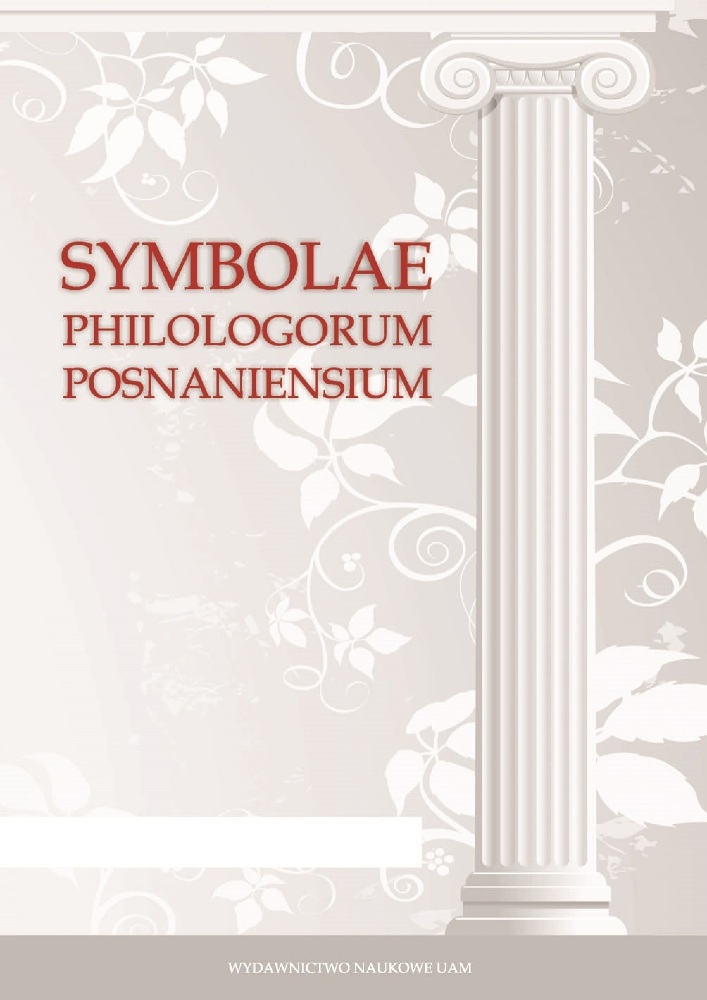Abstrakt
In this article I analyse the theme of love and death as explored by Propertius in his Elegy 4.7. I also attempt
to show that the problem of incongruence between this poem and the neighbouring Elegy 4.8 can be resolved
by means of an aesthetically oriented reading of both poems.
Bibliografia
Allison 1980: J.W. Allison, Propertius 4.7.94, „AJPh” 101, 2 (Summer 1980), 170–173.
Allison 1980a: J.W. Allison, Virgilian Themes in Propertius 4.7 and 8, „CPh” 75, 4 (Oct. 1980), 332–338.
Allison 1984: J.W. Allison, The Cast of Characters in Propertius 4.7, „CW” 77, 6 (Jul.–Aug.
, 355–358.
Baker 1973: R.J. Baker, A Literary Burnt Offering (Propertius 4.7. 77–78), „CPh” 68, 4 (Oct.
, 286–289.
Bobrowski 1997: A. Bobrowski, Mitologia w rzymskiej elegii i liryce miłosnej okresu augustowskiego, Kraków 1997.
Bouquet 1996: J. Bouquet, La nuit, le sommeil et le songe chez les élégiaques latins, „REL” 74 (1996), 182–211.
Corrigan 2013: K. Corrigan, Virgo to Virago. Medea in the Silver Age, Cambridge 2013.
Dufallo 2005: M. Dufallo, The Roman Elegist’s Dead Lover or the Drama of the Desiring Subject, „Phoenix” 59, 1/2 (Spring–Summer 2005), 112–120.
Dufallo 2007: M. Dufallo, The Ghosts of the Past: Latin Literature, the Dead, and Rome’s Transition to a Principate, Columbus 2007.
Foulon 1996: A. Foulon, La mort et l‘au-delà chez Properce, „REL” 74 (1996), 155–168.
Gebhardt 2009: U. Gebhardt, Sermo Iuris: Rechtssprache und Recht in der augusteischen Dichtung, Leiden–Boston 2009.
Glare 2003: Oxford Latin Dictionary, P.G.W. Glare (red.), Oxford 2003.
Guillemin 1950: A. Guillemin, Properce, de Cynthie aux poèmes romains, „REL” 28 (1950),
–193.
Harmon 1986: D.P. Harmon, Religion in the Latin Elegists, „ARNW” II 16,3 (1986), 1909–1973.
Harrison 2013: J. Harrison, Dreams and Dreamig in the Roman Empire, London – New York 2013.
Hübner 1984: U. Hübner, Episches und Elegisches am Anfang des dritten Buches der «Pharsalia», „Hermes” 112, 1 (1984), 227–238.
Hutchinson 2006: Propertius, Elegies. Book IV, G. Hutchinson (red.), Cambridge 2006.
Hutchinson 1984: Propertius and the Unity of the Book, „JRS” 74 (1984), 99–106.
Iser 1980: W. Iser, Apelatywna struktura tekstów: niedookreśloność jako warunek oddziaływania prozy literackiej, przeł. M. Łukasiewicz, „Pamiętnik Literacki” 71/1 (1980).
Jacoby 1905: F. Jacoby, Zur Entstehung der römischen Elegie, „RM” 60 (1905), 38–105.
Kristeva 2007: J. Kristeva, Czarne słońce. Depresja i melancholia, Kraków 2007.
Lovecraft 2008: H.P. Lovecraft, Nadnaturalny horror w literaturze, przeł. A. Ledwożyw, Ł.M. Pogoda, R. Lipski, Warszawa 2008.
Magnelli 2002: E. Magnelli, Ancora sul nuovo Posidippo e la poesia latina: Il ‘freddo letto’,
„ZPE” 140 (2002), 15–16.
Magnelli 2008: E. Magnelli, Minutaglie posidippee, „ZPE” 165 (2008), 49–54.
Magnelli 2010: E. Magnelli, Nicander, [w:] A Companion to Hellenistic Literature, J.J. Claus,
M. Cuypers (red.), Oxford 2010, 211–223.
Mans 1984: M.J. Mans, The Macabre in Seneca’s Tragedies, „Acta Classica” 27 (1984), 101–119.
Murray 2004: Encyclopaedia of the Romantic Era, Ch.J. Murray (red.), London 2004, 448–449.
Papanghelis 1987: T. Papanghelis, Propertius: A Hellenistic Poet on Love and Death, Cambridge 1987.
Pelc 1993: J. Pelc, Barok – epoka przeciwieństw, Warszawa 1993.
Poe 1982: E.A. Poe, The Complete Tales and Poems of Edgar Allan Poe, London 1982.
Pypłacz 2010: J. Pypłacz, The Aesthetics of Senecan Tragedy, Kraków 2010.
Roman 2014: L. Roman, Poetic Autonomy in Ancient Rome, Oxford 2014.
Schiesaro 2003: A. Schiesaro, The Passions in Play. „Thyestes” and the Dynamics of Senecan Drama, Cambridge 2003.
Scioli 2015: E. Scioli, Dream, Fantasy and Visual Art in Roman Elegy, Madison 2015.
Sell 1984: R. Sell, Comedy of Hyperbolic Horror. Seneca, Lucan, and the 20th Century Grotesque, „Neohelicon” 11, 1 (March, 1984), 277–300.
Snodgrass 2005: M.E. Snodgrass, Encyclopedia of Gothic Literature, New York 2005.
Stahl 1985: H.-P. Stahl, Propertius: „Love” and „War”. Individual and State under Augustus, Berkeley – Los Angeles – London 1985.
Sullivan 2010: J.P. Sullivan, Propertius: A Critical Introduction, Cambridge 2010.
Swoboda 1976: M. Swoboda, Sextus Propertius. Szkice krytycznoliterackie, Poznań 1976.
von den Hoff 2004: R. von den Hoff, Horror and Amazement. Colossal mythological statue groups and the new rhetoric of images in the late second and early third century Rome, [w:] Paideia. The World of the Second Sophistic, B. Borg (red.), Berlin – New York 2004, 105–130.
Walin 2009: D. Walin, Cynthia serpens: A Reading of Propertius 4.8, „CJ” 105, 2 (Dec. 2009), 137–151.
Walpole 2001: H. Walpole, The Castle of Otranto, London 2001.
Licencja
